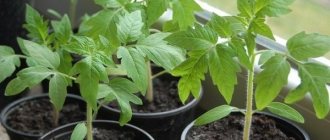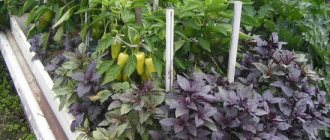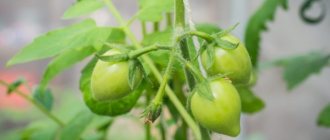Often, even with proper care, tomatoes become rotten and do not produce ovaries. And all because during planting the required distance is not maintained between the bushes. We present clear schemes for planting tomatoes so that you get a good harvest.
Last year, the seedlings suffered from crowding, was it inconvenient to care for the plants and harvest? To avoid these mistakes, you need to know at what distance to plant tomatoes, and adhere to these rules when planting in a greenhouse and open ground.
Planting by eye is used when there are few plants - 10-15 bushes. In other cases, you must definitely arm yourself with a centimeter, pegs and ropes to mark the planted area. You can also make a marker from a board that will make it easier to mark the holes.
- 11 best varieties of tomatoes for greenhouses and open ground – rating from our readers
Get acquainted with the results of the vote conducted by members of the Amateur Tomato Growers Club.
Planting tall tomatoes
Growing tall tomatoes allows you to save space in a greenhouse or open ground. To get a good harvest, you don’t have to plant a lot of plants, because up to 10 fruit clusters grow on one stem of this tomato. Tall tomatoes will not shade each other and will require less care. In addition, they can become a real decoration of a summer cottage, thanks to their elegant appearance.
If you grow tall tomatoes, the distance between rows can be up to 1 m, between bushes - 70 cm. In some cases, the interval can be slightly reduced: 70-90 cm between rows and 50-60 cm between bushes, respectively.
Here is an approximate diagram showing the planting of tomatoes, the distance between individual bushes and rows.
Remember that tall varieties of tomatoes require staking to a support.
- 5 ways to garter tomatoes
How to properly tie up tomatoes in order to support tall bushes and not lose the harvest of large fruits?
What is the importance of properly spacing tomatoes?
The planting scheme is given high priority, since the success of the harvest depends on it, especially if there are many bushes, different varieties are present and maximum yield is expected. The interval between bushes and rows should be such that the plants receive high-quality lighting and air circulates freely between them.
Thickened plantings can lead to such negative consequences as:
- Inhibition of development and decrease in fertility due to shadows cast by neighboring tomatoes.
- Parasitizing strong plants on weak ones, robbing them of nutrients and moisture.
- The susceptibility of seedlings to various kinds of diseases, and poor air circulation and close contact of plants will contribute to the fastest spread of diseases (blight rot, late blight, blackleg).
Important : you should first study the specifics of each variety and prevent mature and developed bushes from coming into contact with each other.
Planting low-growing tomatoes
Low-growing tomatoes produce an early harvest, so they are highly valued by gardeners. When planting tomatoes of these varieties, you can leave up to 30 cm of free space between the bushes, and 50 cm between the rows. Below is the planting distance for low-growing varieties of tomatoes.
A checkerboard planting will be successful, in which up to 10 bushes can fit per 1 sq.m.
- Is it worth growing low-growing tomatoes - 8 arguments in favor
Do you doubt that low-growing tomato varieties can become worthy rivals to giants? We will present arguments that will convince you.
When to plant tomato seedlings in open ground in 2021?
Tomatoes are heat-loving vegetables that do not tolerate frost and cold temperatures. As a result, it is recommended to choose tomato varieties that correspond to the climatic characteristics of the region. Agronomists advise not to overexpose seedlings; overgrown plants take root worse and stop growing if there is not enough space. Even if sowing was carried out earlier than expected, it is better to slow down the growing season using the special “Athlete” product. Its use at an early stage will not affect the further growth of tomatoes in open ground. They usually shed twice with an interval of 10-14 days.
Small seedlings should not be planted with tomatoes either. Until the seedlings become stronger and reach a height of 10-12 cm, the plant should not be stressed. Middle age will make it easier to endure a transplant and even a sudden change in weather.
In order not to make a mistake with the exact date of planting in the garden, you need to take into account several factors:
- variety and manufacturer's recommendations;
- climatic features of the region based on average temperature indicators over the past few years;
- air temperature in the next two weeks;
- soil temperature;
- favorable days according to the Lunar calendar, excluding neutral and prohibited dates for planting in April, May and June.
First of all, it is worth measuring the soil. Its upper layers should show a level of 10-16 degrees Celsius on the thermometer. An ordinary device, often used to measure air temperature in open areas, is suitable as a tool.
It is best to plant when the tomatoes have 6-9 true leaves. At the same time, each bush should not lean to the side. A stable state is the key to good survival in any region. The roots should be visible through the plastic cup.
Planting tomatoes according to the Lunar calendar in 2021
Not all gardeners adhere to the Lunar calendar. However, many farmers have seen its effectiveness from their own experience. The phases of the Moon can have both beneficial and negative effects on the survival and development of any plant. And tomatoes are no exception to the rule!
Of course, in addition to favorable days for landing, other aspects should be adhered to, otherwise there will be no point in miscalculations. After making sure that the weather is good and the earth is warming up, the summer resident can choose any of the days listed below for planting.
- In May, the optimal time will be the following numbers - from 1 to 6, 15 and 19, 24 and 31.
- In June, for Siberia, the Urals and the Leningrad region, it is recommended to plant tomatoes before the 20th, namely: 1 and 11, 15 and 16, 20.
By region
Planting of crops may vary in time depending on the location of the region. In Russia, Ukraine and Belarus, planting begins in early May and continues until mid-June. The only exceptions include the southern regions, namely: Krasnodar Territory and Kuban, the Crimean Peninsula. In these places, depending on the weather, tomatoes can be cultivated from mid-April.
In central Russia, as well as most regions of Belarus and Ukraine, planting begins in the second week of May and ends in early June.
In the Central part, as well as the Moscow region and the Moscow region, dates are chosen based on one month - May. Depending on the weather, landing can begin either in the early days or in the middle or even at the end of the month.
The last to be planted are regions with unstable and cold climates, where warm weather arrives later than usual. For cultivation, early varieties are taken as a basis, so that the short summer allows the harvest of ripened fruits. In particular, this applies to the Urals and Siberia.
Distance between tomatoes in a greenhouse
The main problem when planting in a greenhouse is to calculate the size of the beds and the passage between them. This depends on the width of the greenhouse. For buildings up to 3.5 m, you can use several planting methods: with two or three beds. Accordingly, there will be one or two passes. Here are some sample diagrams.
The presence of one passage is not always convenient for caring for plants, but it allows you to use the soil in the greenhouse as economically as possible. This is especially true for small buildings up to 2.5 m wide.
Before deciding at what distance to plant tomatoes, keep in mind that one plant needs at least 0.3 square meters of soil. The average distance between bushes is 40 cm, and between rows is 50-60 cm.
Two passages provide more space for gardening work. But there is another danger here: the plants in the central bed may not have enough light. To solve this problem, plant tall varieties of tomatoes here.
The beds should not exceed 1.2 m in width, so that it is convenient to care for plants close to the wall. Passages less than 40 cm are also irrational. Their optimal size is 50-70 cm.
For large greenhouses with a width of more than 3.5 m, we offer this planting option.
In a large greenhouse you can plant on a grand scale. But it’s worth thinking about lighting and watering the plants in advance. Hybrids usually grow very large, so they can be placed in a narrow bed in one row, and compact varieties can be placed in 2-3 rows in wide beds. Tall tomatoes are placed closer to the center of the greenhouse, and medium- and low-growing ones near the walls. This way all plants will have enough sunny color.
Tomatoes are light-loving plants, so do not allow thickening when planting. If possible, each tomato leaf should receive enough light. The lower leaves and stepsons must be removed in time.
- Growing tomatoes in a greenhouse - the secrets of a bountiful harvest
Do you want to reap a rich harvest of delicious fruits? These rules of agricultural technology will help you with this!
What scheme should I use to plant plants in the garden bed?
There are different variations in the location of tomato seedlings in the open ground, depending on the varieties planted.
Square-nested
A rather old scheme known to gardeners since Soviet times and which has not lost its relevance today. Its essence lies in planting tomatoes in nests containing from one to three plants. After a certain time, the least viable plant is removed, and the remaining ones are tied up. In the transverse direction, the distance should be 80 centimeters, since a furrow for irrigation is installed here. In the longitudinal direction, the empty space is 60 centimeters.
Caring for crops when using this system is more difficult compared to others, but processing time is reduced and productivity increases. The scheme is great for small areas and tall types of tomatoes .
Private
The simplest planting method that even a novice gardener can get used to. In accordance with this scheme, the distance depends on the height of the tomatoes and can be from 30 to 50 cm between bushes in a row, and from 50 to 80 cm between rows. The planting style is focused on low-growing, medium-growing and single-stem tall varieties. The advantages of the row scheme include a high level of illumination of the bushes and good air circulation, but at the same time it requires a substantial space, and it is also inconvenient to harvest.
Also, when placing, it is worth considering the ripening time of tomatoes :
- Early ripening varieties will satisfy the distance between holes of 30 cm and between rows of 50 cm.
- Mid-season varieties require 45 cm of free space between holes, and at least 65 cm between rows.
- Late-ripening varieties need half a meter of space between holes and a width between rows of 70-80 cm.
Attention : it is recommended to make markings before planting.
Chess
Checkerboard planting is optimal for short and medium-sized tomatoes formed into 2-3 stems. It is necessary to create two rows and place the holes depending on the number of stems and variety:
- Between medium-sized tomatoes with three stems - 50-60 cm.
- Between medium-sized tomatoes with one stem - 30-40 cm.
- Between tall tomatoes - up to 70 centimeters.
The width between rows is 40-50 centimeters. The bushes of the second row are placed in the spaces of the first.
It is recommended to move sequentially from row to row rather than starting with two at once.
Tape-nested or parallel
The tape-nesting method is similar to the chess method , since it also involves the formation of two rows, but parallel. Then a meter wide path is created and two rows are planted again. The distance between rows is 40 cm. The spacing between bushes depends on the varieties:
- Low-growing and branched ones are located 40 cm from each other.
- Vigorous varieties like a distance of 60-70 cm.
The scheme is used for industrial cultivation of crops because agrotechnical techniques are easily applicable to it, the crop is easy to harvest and it is possible to get close to the bush, but at the same time it requires a lot of space.
Influence of variety and ripening period
So, let's start answering the question of what should be the correct distance between tomato bushes. An important factor is the variety and type of tomato, depending on which the recommendations for planting and care vary. Therefore, before you start planting, you should carefully study all the information provided on the package of seeds.
The distance will vary depending on how quickly the particular type of tomato ripens.
- Early fruits - it is recommended to leave about 30 cm among the seedlings, about 50 cm should be left between the beds
- Medium varieties - the gap will be 60-65 cm between the beds, and about 50 cm between the seedlings
- Late species - the distance between the beds is about 75 cm, leave no more than half a meter between the bushes
Every gardener knows that the soil in the garden must be used very sparingly in order to be able to plant as many plants and crops as possible. Regarding tomatoes, you can plant grass in the space between the beds. Do not worry that their presence will negatively affect the growth of the vegetable.
Tatyana Orlova (candidate of agricultural sciences):
As a rule, late-ripening varieties of vegetable crops are the most productive. This applies not only to tomatoes. The longer the plant grows, the greater the above-ground mass it creates. Therefore, all late-ripening vegetable crops are planted at a greater distance than early-ripening ones.
Landing
Before moving the seedlings to their main place of residence, you should consider providing them with a font to protect them from pests. For this purpose, you can use homemade solutions or systemic insecticides. Now you need to make a deep furrow into which the seedlings will be planted. Fertilizers must be added. For this purpose, you can use vermicompost, peat, organic or mineral preparations, infusion of chicken droppings or manure. The main thing is not to overdo it with fertilizers, otherwise you risk burning the roots. Fill the furrow from above with water and wait until it is absorbed. Next, you can distribute the seedlings along the furrow. There is another important feature here: tomatoes must be planted at an angle. This will promote further growth and development of the root system. Also try to plant plants deeper to form additional roots on the stem.
Square nest planting
With this technology, three tomato seedlings are planted in one hole (nest). Immediately mark several parallel lines, 80 cm apart, then make nests, 60 cm apart.
After the seedlings adapt to new conditions, one of the weakest plants is carefully removed, and the remaining two are tied up.
So, it is advisable to grow indeterminate varieties in rows so that the massive bushes receive enough light and the roots do not experience a lack of moisture and nutrients.
It is advisable to plant medium-sized and determinate tomatoes in a checkerboard pattern. This will save a lot of space.
Standard low-growing tomatoes will give a rich harvest when planted in parallel rows.
But despite all the recommendations, at what distance to plant tomato seedlings depends primarily on the availability of free space and the preferences of the gardener.
Why is it so important to maintain the recommended distance between bushes?
To get a rich harvest, you need to correctly place the seedlings when planting. Many gardeners, in order to save space, plant plants too densely, which often leads to undesirable consequences:
- Plants located close to each other shade each other, and therefore cannot fully develop and produce fruits in the required quantity.
- As a result of the shade from tomato foliage, tomatoes take much longer to ripen.
- If the root system of a plant is well developed, it suppresses the growth of neighboring bushes.
- Caring for condensed tomato plantings becomes much more complicated. Bushes are more difficult to weed, pinch, spray, etc.
- Mold may form because the soil does not have time to dry out between waterings.
- As a result of close contact of densely spaced tomato leaves, pests and diseases quickly spread if they appear on one of the bushes.
- There may be difficulties with pollination, since bees do not have free access to flowers.
Thus, dense placement of tomato bushes can lead to a lack of moisture and nutrients, the appearance of diseases and pests, delayed fruit ripening and other consequences that have a negative impact on crop yields.
Planting seedlings with a large interval between bushes is also not very good, since then you will have to give up more land for planting, which is not very rational. That is why it is important for a competent gardener to know at what distance to plant tomatoes.
Neighbors and predecessors
One of the key points: planting tomatoes in open ground must be done taking into account proper crop rotation.
What is better to place nearby?
Tomato is a plant of the Solanaceae family. The same family includes crops such as potatoes, eggplant, vegetable peppers, capsicums, and tobacco. The belonging of plants to the same family makes them susceptible to the same diseases, especially their main common enemy - late blight. Therefore, planting them in neighboring areas is not recommended.
Ideal neighbors for tomatoes are onions, garlic, carrots, mint, sage, corn, radish, celery, spinach, parsley, and basil.
So, onions, garlic, and radishes will protect tomatoes from spider mites, aphids, and flea beetles. And flowers such as marigolds and calendula will not only act as a reliable protector of nightshades from almost all pests, but will also add more decorative value to the garden plot. And tall corn will reliably protect heat-loving tomatoes from wind and drafts.
Tomatoes also have antagonists. Broccoli, cauliflower and white cabbage, fennel, and dill will have an overwhelming effect on them.
cucumbers
The most popular crops in all household plots are tomatoes and cucumbers. However, is it possible to plant cucumbers nearby? They cannot be planted in adjacent beds. The thing is that these crops require completely different care: cucumbers like abundant watering and high levels of humidity, tomatoes prefer dry air and poor watering.
Large leaves of cucumbers evaporate a lot of moisture, additional moisture is added by abundant watering of this crop, so tomatoes begin to be increasingly susceptible to fungal and bacterial diseases, their flowers are not pollinated, yields drop, and the taste becomes a little bitter.
What is permissible to cultivate after tomatoes next year?
The best option is to sow legumes (peas, beans) and herbs (parsley, dill, celery), which compensate for the nitrogen consumed by tomatoes in the soil. Onions and garlic planted in place of tomatoes will perfectly improve the soil health, and they will also produce a bountiful harvest.
One of the basic rules of crop rotation says: root crops are planted in place of fruits and vice versa. Simply put, “the roots alternate with the tops.” A good harvest is produced by carrots, beets, radishes, radishes, planted in the area after the tomatoes. Cucumbers, zucchini, and cabbage are not afraid of diseases typical of tomatoes.
After what can and cannot be grown?
In order to prevent soil depletion, it is necessary to alternate planting fruit crops and root crops. It is best to plant tomatoes in areas that last year were allocated for turnips, carrots, beets, and green onions. It is acceptable if tomatoes are located in the place of cucumbers, zucchini, cabbage.
The ideal option is to pre-sow green manure on a plot of land allocated for tomatoes - green fertilizers that improve the structure of the soil, enrich it with nitrogen, and inhibit the growth of weeds. Green manure products include oats, mustard, buckwheat, clover, beans, and lupine.
It is strictly forbidden to plant tomatoes in place of other nightshades: potatoes, eggplant, peppers, physalis, tobacco. Regardless of the planting method, plants need careful care. A vegetable grower should not forget about this, since planting a plant correctly does not mean reaping a rich harvest. Only the gardener’s care, patience and diligence can ensure the achievement of his goal.
Planting in rows
This is the most common technology among gardeners. It is used by both experienced and novice farmers. With this method, tomatoes are planted on the plot in rows according to pre-made markings. The technology is suitable for determinate and standard varieties. At what distance should tomatoes be planted in open ground? Depending on the height of the tomatoes in one row, there may be 25-45 cm between bushes, and 45-80 cm between rows.
Seedlings are planted in rows only in open ground, since this technology requires a large area. Advantages of this method:
- good plant lighting;
- easier bush care;
- excellent air circulation.
Thanks to these factors, tomatoes can grow freely and produce a good harvest in a timely manner.










